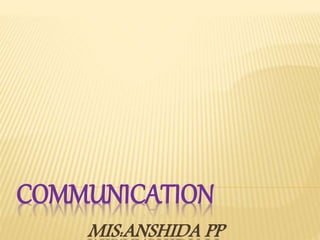Recommended
Interpersonal Health Communication Interpersonal Media for Individual Health EducationInterpersonal Health Communication Interpersonal Media for Individual Health ...

Interpersonal Health Communication Interpersonal Media for Individual Health ...Mohammad Aslam Shaiekh
Recommended
Interpersonal Health Communication Interpersonal Media for Individual Health EducationInterpersonal Health Communication Interpersonal Media for Individual Health ...

Interpersonal Health Communication Interpersonal Media for Individual Health ...Mohammad Aslam Shaiekh
More Related Content
What's hot
What's hot (8)
Nursing Leaders influencing politics and acting as patient advocates

Nursing Leaders influencing politics and acting as patient advocates
Viewers also liked
Viewers also liked (6)
Similar to Communication
Similar to Communication (20)
Communication
- 2. INTRODUCTION COMMUNICATION IS THE BASIS OF FOR ALL HUMAN INTERACTION. IT IS ONE OF THE MOST VITAL COMPONENTS OF NURSING PRACTICE. COMMUNICATION CONSIST OF SIGNALS MAD BY ONE PERSON THAT HAVE MEANING OF ANOTHER PERSON WHICH AFFECT THEIR BEHAVIOUR AND ACTION,LEADING TO INTERACTION.
- 3. DEFINITION “COMMUNICATION IS A DYNAMIC, RESIPROCAL PROCESS OF SENDING AND RECEIVING INFORMATION”.
- 4. PURPOSES TO PROMOTE SOCIALIZATION. TO GATHER INFORMATION FOR PURPOSE OF ASSESSMENT. HEALTH TEACHING AND CO-ORDINATING WITHOTHER MEMBERS OF THE HEALTH CARETEAM.
- 5. BASIC ELEMENTS SENDER MESSAGE METHOD RECIEVER FEEDBACK INFLUENCE
- 6. METHODS OF COMMUNICATION VERBAL COMMUNICATION NON VERBAL COMMUNICATION SYMBOLIC COMMUNICATION META COMMUNICATION ELECTRONIC COMMUNICATION
- 7. VERBAL COMMUNICATION… IT IS THE USE OF THE SPOKEN/WRITTEN WORDS TO SENT A MESSAGE. FACTORS INFLUENCING VERBAL COMMUNICATION VOCABULARY SPEAKING/ LISTENING WRITING/READING DENOTATIVE /CANNOTATIVE PACING INTONATION CLARITY/BREVITY TIMING/RELEVANCE CREDIBILITY HUMOR
- 8. NON VERBAL COMMUNICATION… IT IS THE EXCHANGE OF MESSAGES WITHOUT USE OF WORDS, AND IT INCLUDE ALL OF THE FIVE SENSES INVOLVE THE SPOKEN/WRITTEN WORDS. FACTORS INFLUENCING…… • PERSONAL APPEARANCE • BODY POSITION • FACIAL EXPRESSION • EYE CONTACT • GESTURES • SOUNDS
- 9. SYMBOLIC COMMUNICATION THE VERBAL AND NON VERBAL SYMBOLSMS USED BY OTHERS TO CONVEY MEANING ART AND MUSIC ARE FORMS OF SYMBOLIC COMMUNICATION.
- 10. META COMMUNICATION IT IS BROUGHT TERM THAT REFERS TO ALL FACTORS THAT INFLUENCE COMMUNICATION, AWARNESS OF INFLUENCING FACTORS HELP PEOPLE BETTER UNDERSTAND WHAT IS COMMUNICATE.
- 11. ELECTRONIC COMMUNICATION • MANY HEALTH CARE AGENCIES MOVING TOWARD ELETRONIC MEDICAL RECORDS, WHERE NURSES DOCUMENT THEIR ASSESSMENT AND NURSING CARE. E-MAIL CAN BE USE IN HEALTH CARE FACILITIES FOR MANY PURPOSE SCHEDULE AND CONFIRM APPOINTMENTS, REPORT NORMAL LAB RESULT.
- 12. BARRIERS OF COMMUNICATION PHYSIOLOGICAL BARRIERS POOR RETENTION DUE TO MEMORY PROBLEM LACK OF ATTENTION DISCOMFORT DUE TO ILLNESS POOR SENSORY PERCEPTION LEARNING PROBLEM POOR LISTERNING SKILLS INFORMATION OVERLOAD
